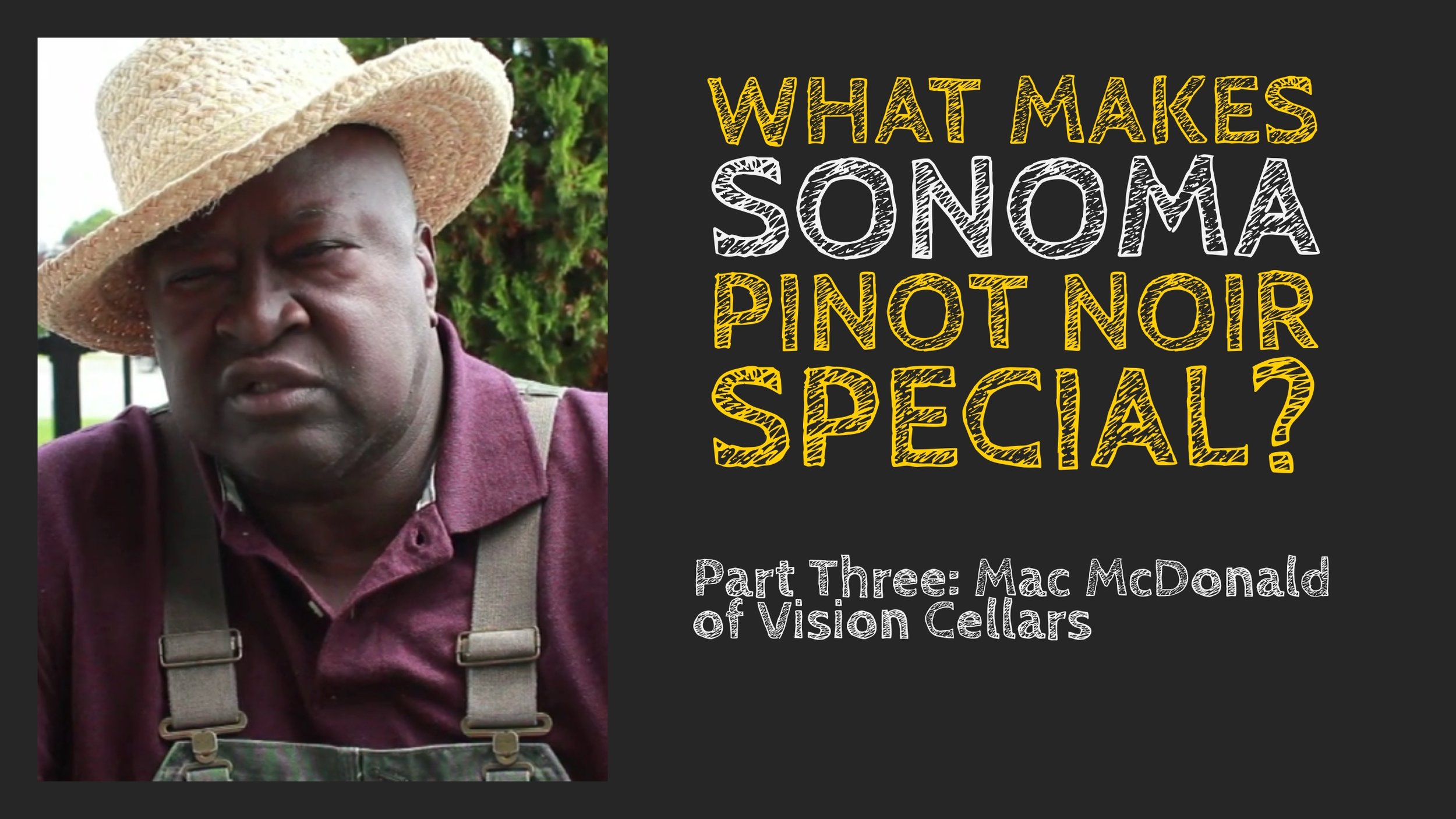This the third part of my video interview with Mac McDonald of Vision Cellars. In this segment, McDonald talks about why Sonoma County is such a great place for Pinot Noir and why it is special.
- The first part of the interview is here. "From Rural Texas to Napa Valley Wine Country."
- The second part of the interview is here. "How (and Why) to Grow Pinot Noir."
Please enjoy this six minute video or read the transcript underneath it.
This is Episode #57 of Understanding Wine with Austin Beeman.
Mac McDonald:
From my mind, what makes California fruit a little bit more consistent is that we've kind of figured out what type of soil condition, what type of weather patterns that you have is the best area to grow Pinot Noir. We've found that nice cooler areas, cool at night, maybe when it's a little bit warmer during the day, you know 80s is not to high into the 100s and stuff like that. Well, its more ideal for drinking and making Pinot Noir because you don't get the over ripe fruit all the time, unless you purposely trying to do that. So I think we are a little bit more consistent and we do have a tendency to get a little bit more alcohol you see than Burgundy or Oregon. I think when you look at Northern California, I think we're pretty consistent in finding a good location to grow Pinot Noir and I think that, that's really the determining factor.
Burgundy, you know they don't get a lot of heat and in that Burgundy area. So your alcohol normally is not as high and the wine can last a lot longer. Of course, we make our wines in California so that they'll be able to be consumed a little bit earlier. Now when I get into California itself and I think about Carneros, I think about a more dense, maybe a little bit more hardier of Pinot Noir because you don't have a lot of hot, hot weather in that Carneros area. It's quite close to the water. You get over into Sonoma County where I live, Sonoma County, Russian River Valley, ideal for Pinot Noir.
Our property is maybe three quarters of a mile from the Russian River, which is nice and cool in there. When the ocean itself is about 45 miles away. It's nice and cool in that Russian River Valley, where you get up in the 80's, once in a while you get up, you know 95 or something like that, but normally it's in the 80's and at night it kind of cools down so you get more of a cherry, real ripe plum kind of a fruit from that area, not as dark as it is in Carneros. Then when you get down to Monterey County, to the Santa Lucia Highland, particularly upper part of the Santa Lucia Highland, around Solidad, in that area. I purchased fruit from the Gary's in Rosella's Vineyard and a Las Ventura's vineyard that's owned by the Wagner family, and I tell you, that's an ideal area itself for growing Pinot Noir.
You still get that little dense kind of a fruit there. The acid can be high in that area, a lot higher than it is in I say Russian River Valley, Sonoma County, or Carneros, or in Napa area and part of it is in Sonoma. The acids can be pretty high down in the Santa Lucia Highland and into Monterey County. When you get down past Santa Barbara and that area, now you're picking up a little bit more ripe of fruit, a little bit lighter fruit and you can kind of get more of what I call that candy apple kind of a bright sweet kind of a real cherry, real not wild cherry, but real bing kind of a light cherry kind of a wine. With maybe a little bit of berries and the typical raspberry flavors down there.
I don't think that, that's a problem with that, but I think we're consistent in all the areas that we're making Pinot Noir in, but finding out that the temperature in except in those areas makes a big difference in how Pinot Noir should be coming out and how the trellising of the vines and how you can actually get the exposure to the grape to the sun shine that you need, but we can't change the sun. We can change how the sun hit the fruit itself by the way we prune it or by we go out and pick the leaves off of it. So I think overall, California's learned how to farm is the bottom line.
Now Oregon, a lot of folks in Oregon they kind of maybe live there, made wine in California so they've taken a lot of the practice up there that we had. They started out in Oregon using the fruit from that area and not trying to make it a California Pinot Noir style. They started out real light. They're gonna get a lot of sun, lot of heat. So they were able to just make a wine from the area and it was so different than California and I can remember when I used to go up there and I'd taste those Pinot Noir's and I use to think, "Oh, what do these guys think they doing?" Because, I was suggested to drink in a little bit different style of Pinot Noir. But I think overall, they doing a great job. They're making their Pinot Noirs up in Oregon and parts of Washington as well now.
Check out more great wine content






















